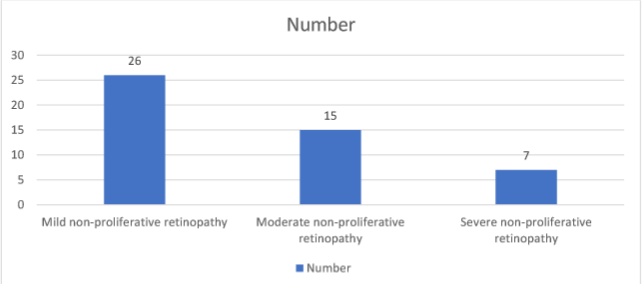Assessment of Prevalence of Diabetic Retinopathy
Main Article Content
Abstract
Background: Diabetic retinopathy is a retinal vascular condition which takes place as a consequence of DM. The current research was carried out to evaluate prevalence of diabetic retinopathy.
Materials & Methods:106 type II diabetes mellitus patients of both genders were included. Retinopathy was labelled as mild non-proliferative retinopathy, moderate non-proliferative retinopathy and severe retinopathy. Parameters such as duration of diabetes, family history, hypertension, BMI etc. had been documented.
Results: amongst 106 subjects, men were 60 whereas women were forty six. Amongst 106 type II DM subjects, mild non-proliferative retinopathy was seen in 26, moderate non-proliferative retinopathy in 15 and severe non-proliferative retinopathy in 7. The difference was non- significant (P> 0.05).DR was present in patients with BMI 24.9 in 6, 25-29.9 in 14 and >30 in 28. Hypertension was seen in 31, family history was seen in 25 and period of DM was <5 years in 14 whereas 5-10 years in 34. The difference was significant.
Conclusion: There had been a high prevalence of diabetic retinopathy. Maximum cases of DR was seen in patients with positive family history of diabetes, BMI >30, hypertension and with 5-10 years of diabetes.
Article Details
References
Schrier RW, Estacio RO, Esler A, Mehler P. Effects of aggressive blood pressure control in normotensive type 2 diabetic patients on albuminuria, retinopathy and strokes. Kidney Int. 2002;61:1086-1097.
Klein R, Klein BE, Moss SE, Davis MD, DeMets DL. The Wisconsin Epidemiologic Study of Diabetic Retinopathy, III: prevalence and risk of diabetic retinopathy when age at diagnosis is 30 or more years. Arch Ophthalmol. 1984;102:527- 532.
Klein R, Klein BE, Moss SE, Linton KL. The Beaver Dam Eye Study: retinopathy in adults with newly discovered and previously diagnosed diabetes mellitus. Ophthalmology. 1992;99:58-62.
Leske MC, Wu SY, Hyman L, et al. Diabetic retinopathy in a black population: the Barbados Eye Study. Ophthalmology. 1999;106:1893-1899.
Mitchell P, Smith W, Wang JJ, Attebo K. Prevalence of diabetic retinopathy in an older community: the Blue Mountains Eye Study. Ophthalmology. 1998;105: 406-411.
West SK, Klein R, Rodriguez J, et al. Diabetes and diabetic retinopathy in a MexicanAmerican population: Proyecto VER. Diabetes Care. 2001;24:1204-1209.
Lachin JM. Biostatistical Methods. New York, NY: John Wiley & Sons Inc; 2000. 22. Boyle JP, Honeycutt AA, Narayan KM, et al. Projection of diabetes burden through 2050: impact of changing demography and disease prevalence in the US. Diabetes Care. 2001;24:1936-1940.
Ferris FL III. How effective are treatments for diabetic retinopathy? JAMA. 1993; 269:1290-1291.
The Eye Diseases Prevalence Research Group. Causes and prevalence of visual impairment among adults in the United States. Arch Ophthalmol. 2004;122:477- 485.
Roy MS, Klein R, O’Colmain BJ, et al. The prevalence of diabetic retinopathy among adult type 1 diabetic persons in the United States. Arch Ophthalmol. 2004;122: 546-551.
Alemu Mersha G, Alimaw YA, Woredekal AT. Prevalence of diabetic retinopathy among diabetic patients in Northwest Ethiopia—A cross sectional hospital- based study. PLoS ONE 2022;17(1): e0262664.
Kempen JH, O'Colmain BJ, Leske MC, Haffner SM, Klein R, Moss SE, Taylor HR, Hamman RF. The prevalence of diabetic retinopathy among adults in the United States. Archives of ophthalmology (Chicago, Ill.: 1960). 2004 Apr 1;122(4):552-63.
Sjolie AK, Klein R, Porta M, Orchard T, Fuller J, Parving HH, et al. Effect of candesartan on progression and regression of retinopathy in type 2 diabetes (DIRECT-Protect 2): a randomised placebo-controlled trial. Lancet. 2008;372(9647):1385–93.
Bourne RR, Stevens GA, White RA, Smith JL, Flaxman SR, Price H, et al. Causes of vision loss worldwide, 1990–2010: A systematic analysis. Lancet Glob Health. 2013;1(6):e339–49.

